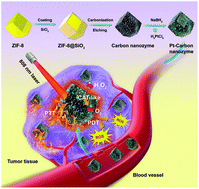Platinum-carbon-integrated nanozymes for enhanced tumor photodynamic and photothermal therapy†
Abstract
Tumor hypoxia compromises the effects of photodynamic therapy that consumes oxygen in the therapeutic process. Herein, a platinum (Pt)-carbon-integrated nanozyme with favorable catalase-like activity and photosensitizing properties was successfully constructed by immobilizing an ultrasmall Pt nanozyme into a MOF-derived carbon nanozyme through an in situ reduction strategy. The integration of a Pt nanozyme significantly improves the catalase activity of a carbon nanozyme that can effectively catalyze the decomposition of endogenous hydrogen peroxide to produce oxygen to improve the effects of photodynamic therapy. In addition, the integration of a Pt nanozyme also enhances the intrinsic photothermal performance of a carbon nanozyme. Combining the improved catalase-like activity with the enhanced photothermal properties together, the Pt-carbon nanozyme exhibits remarkable tumor inhibition ability in vivo. Thus, utilizing the enzymatic activity and photothermal/photosensitizing properties of nanozymes has great potential to overcome the limitations of traditional therapeutic strategies, and could inspire new directions for nanozyme-based biomedical applications.



 Please wait while we load your content...
Please wait while we load your content...